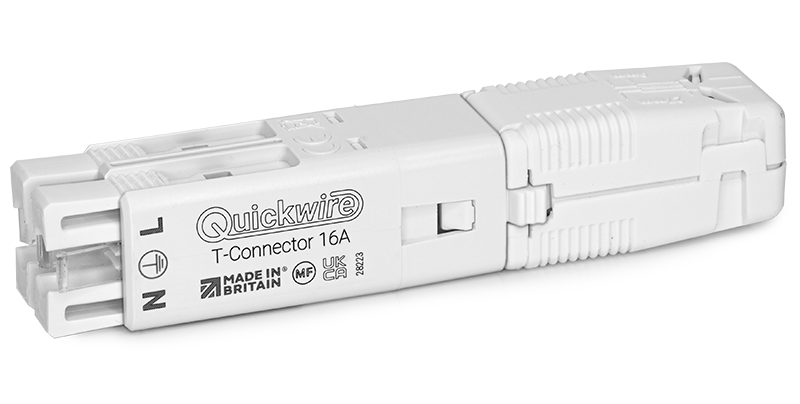Have you considered the Quickwire products?
Small LED Ceiling Light
- Thread starter JohnW2
- Start date

T-Connector Plug & Socket
The plug-in T-Connector is a 3 pole plug and socket: The plug accepts flexible cable and the socket consists of two Quickwire solid core twin and earth, loop in loop out connections.
Good to see you - it's been quite a long time. I hope all is well with you and yours.Have you considered the Quickwire products?
No, I had not considered Quickwire products, because I was not aware of them
However, as far as I can make out from the datasheet and video, the one to which Suritsoff has just linked does not have provision for a fourth conductor (i.e. a 'loop' terminal. Are you aware of any Quickwire products we do have that?
Kind Regards, John
Look at the switch and load on the quickwire website This is a 4 terminals jb.
This is the link to the page. https://www.quickwire.co.uk/product/switch-load-16a/
Hope it helps.
This is the link to the page. https://www.quickwire.co.uk/product/switch-load-16a/
Hope it helps.
Many thanks.Look at the switch and load on the quickwire website This is a 4 terminals jb.
This is the link to the page. https://www.quickwire.co.uk/product/switch-load-16a/
Hope it helps.
Functionally, that is just what I need (see diagram below). However, the one apparent issue is that, in my application, the "load" cable would really have to be flex (very probably the pre-wired bit of flex sticking out of the light fitting) and I'm not sure how/if that could be got into their 'push' terminals. It could be that by using their "cable removal tool" (does one of those come with the connector?) one could open up the terminal enough to get flex in - do you know if that would work?
Kind Regards, John
Can you run a 1mill cable and connect to the flex inside your light fitting?
Possibly, if I can get the fitting apart - it currently just has a 6 inch bit of 2-core flex emerging from it.Can you run a 1mill cable and connect to the flex inside your light fitting?
If getting into the ('throwaway'!) fitting proves problematical, suppose another, but rather messy (albeit virtually never seen), possibility would be to have a second small connector joining a short bit of 1 mm² T+E to the fitting's flex.
You could use a "switch and load" to handle the switch along with a "T-Connector Plug & Socket" to transition from T&E to flex. Both items could then be fed through the hole.
I agree it's suboptimal to have to use two separate items though.
I agree it's suboptimal to have to use two separate items though.
The light fitting is confusing the issue. Can you post a photo?
It was actually murdochat who suggested the fitting (post #5), but when I got one it appeared ideal for my purpose. See photos.The light fitting is confusing the issue. Can you post a photo?
On the face of it, I can 'get in' (to change the lead) by just undoing 8 screws - but I've had unwelcome surprised in the past when opening up such things
Kind Regards, John
could you use 1 of each type in seriesMany thanks.
Functionally, that is just what I need (see diagram below). However, the one apparent issue is that, in my application, the "load" cable would really have to be flex (very probably the pre-wired bit of flex sticking out of the light fitting) and I'm not sure how/if that could be got into their 'push' terminals. It could be that by using their "cable removal tool" (does one of those come with the connector?) one could open up the terminal enough to get flex in - do you know if that would work?
View attachment 377441
Kind Regards, John
Yes, that's the sort of "second small connector" I had in mind - but, as you go on to say ...You could use a "switch and load" to handle the switch along with a "T-Connector Plug & Socket" to transition from T&E to flex. Both items could then be fed through the hole.
As for the "T-connector Plug and Socket", the spec says that the plug has screw terminals which are suitable for "1 x Flexible (Class 5/6 conductors) or 1 x Rigid (Class 1 conductors)", so I presume that must be true (although I don't know what these 'C;asses' of conductors are), even though the instructions talk only about the push-in terminals (presumably for the 'socket'). Do you know if that is the case?I agree it's suboptimal to have to use two separate items though.
Pay attention to previous (and subsequent!) postscould you use 1 of each type in series
You could try connecting the flex. If that fails, is the well deep enough for you to run t&e and connect using a couple of wagos?
Presumablly IEC conductor classes.although I don't know what these 'C;asses' of conductors are
Class 1 is "solid"
Class 2 is "stranded" (conduit singles and similar)
Class 5 is "fine stranded" or "flexible" (flex and similar)
Class 6 is "extra fine stranded" or "extra flexible" (often seen in test leads, welding cables and similar)
Do you know if that is the case?
DIYnot Local
Staff member
If you need to find a tradesperson to get your job done, please try our local search below, or if you are doing it yourself you can find suppliers local to you.
Select the supplier or trade you require, enter your location to begin your search.
Please select a service and enter a location to continue...
Are you a trade or supplier? You can create your listing free at DIYnot Local
Similar threads
- Replies
- 4
- Views
- 1K
- Replies
- 17
- Views
- 13K

